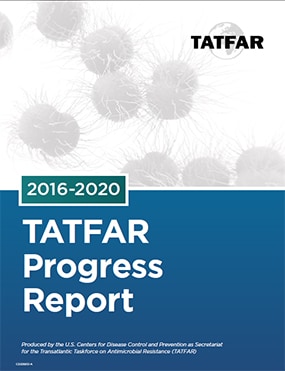About TATFAR
How TATFAR Started
The growing global threat of antimicrobial resistance (often called AR in the U.S. and AMR elsewhere) was recognized in the 2009 U.S.-European Union (EU) Summit Declaration. TATFAR’s technical experts from Canada, the European Union (EU), Norway, the United Kingdom (U.K.), and United States (U.S.) collaborate and share best practices to strengthen domestic and global efforts in these four Key Areas:
TATFAR summarized its contribution to fighting AMR with several fact sheets that are available to download on the Fact Sheets: Key Area Summaries webpage.
- Appropriate antimicrobial use in human and veterinary medicine
- Surveillance and prevention of AMR
- Strategies to improve financial incentives, access, research, and development of antimicrobial drugs, diagnostics, and alternatives
- Cross-cutting actions to improve awareness and disseminate information from TATFAR
TATFAR Work
In 2009, TATFAR identified and adopted 17 recommendations for future collaborations between the U.S. and the EU. Collaboration has led to:
- Increased information exchange
- Understanding of best approaches and practices
- Development of peer relationships
TATFAR members currently collaborate on 18 draft actions aimed at coordinating efforts to address AMR.
TATFAR Work Plans
TATFAR was created with the goal of improving cooperation between the U.S. and the EU in the three key areas: appropriate therapeutic use of antimicrobial drugs in medical and veterinary communities, prevention of healthcare-and-community-associated infections, and strategies for improving the pipeline of new antimicrobial drugs.
In May 2014, the taskforce released a report summarizing the progress and the outcomes of the implementation of the original 17 recommendations. The taskforce decided to continue with 15 recommendations, retire two, and create one new recommendation for collaboration 2014-2016.
While significant progress has been made, concern related to AMR continues to escalate. In October 2015, TATFAR revised its work plan and extended the collaboration for an additional five years (2016-2020). All progress since the 2014 Progress Report [PDF – 86 Pages] is shared on this website.
In 2021, TATFAR members developed and adopted a new work plan for collaboration to continue through 2026.
The taskforce will continue with 11 actions and establish 7 new actions for collaboration.
TATFAR Secretariat
Since 2014, CDC has provided the secretariat for the taskforce and publishes documents and updates relating to the work of the taskforce on this website. The European Centre for Disease Prevention and Control (ECDC) provided the secretariat from 2009-2013.
